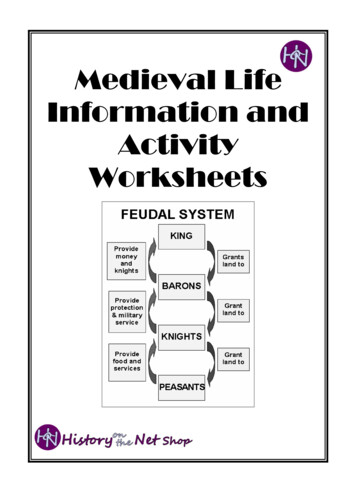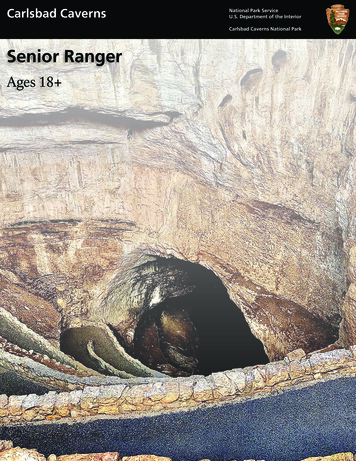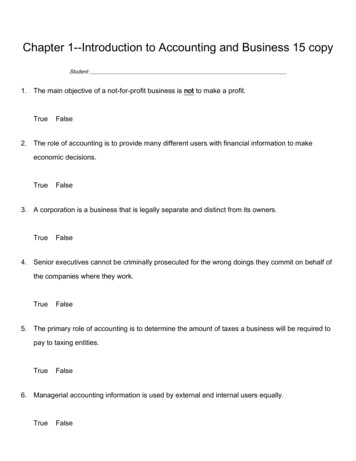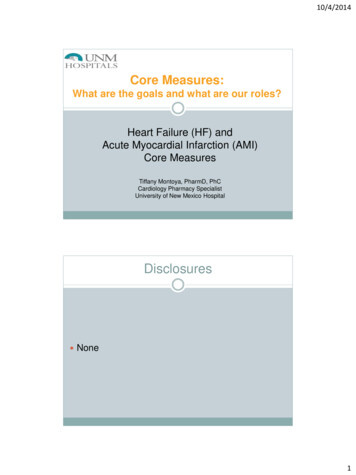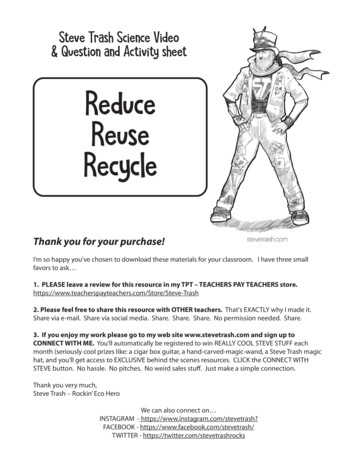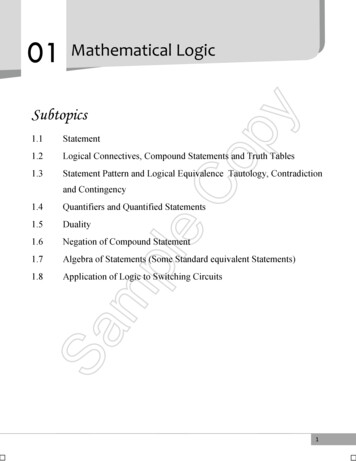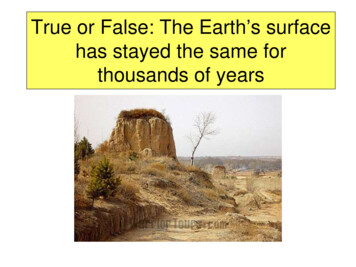
Transcription
True or False: The Earth’s surfacehas stayed the same forthousands of years
True or False: The Earth’s surfacehas stayed the same for thousands ofyearsThe Earth’s surface is alwayschanging!
Earth’s Changing Surface Weathering, erosion, and deposition act together in acycle that wears down and builds up Earth’s surfaceWeathering– Breaks downDeposition –deposits / buildsErosionmoves-
WeatheringThe breakdown of Earth’s crust into smallerpieces.Must occur beforeerosion can happen No movement usuallyoccurs. Sediments- naturallyoccurring material thatis broken down byprocesses ofweathering;small/tiny pieces of rock
Physical/MechanicalWeatheringthe process of breaking down Earth’s surfaceinto smaller pieces – similar to a physicalchangePhysical Weathering -- The steep walls herewere carved out by moving waterPalo Duro Canyon in the HighPlains Eco-Region
1.Water2.Ice3.Wind4.Gravity5.OrganismsCauses of PhysicalWeatheringEnchanted Rock in the LlanoUplift Eco-regionExfoliation-warming and coolingof rocks over time causes rocksto peel into sheets
Chemical WeatheringChemical weathering occurs when chemical reactionsdissolve the minerals in rocks or changes them intodifferent minerals (rusting, acid breakdown, etc)This cave was formed byslightly acidic waterdissolving the limestone
Causes of ChemicalWeatheringNatural Bridge Caverns in Texas1.Oxidation2.Hydration3.Carbonation
Let’s compare Please draw a Venn diagram and comparechemical and physical weathering.How are they similar/different?
Water causes weatheringWhat evidence ofweathering do you seein this picture?
Wind causes weatheringWhy wasn’t this massof land weatheredaway?What evidence ofweathering do you seein this picture?
Ice causes weatheringDescribe how icecauses weathering?
ErosionThe process by which water, ice, wind orgravity move sediments.What evidence oferosion do you see inthis picture?
Erosion is Movement ofSediment! Erosion is theprocess by whichweathered rock andsoil (sediment) aremoved from oneplace to another. Erosion carves theEarth's surfacecreating canyons,gorges, and evenbeaches.What do you think has causedthis rock to look this way?
Erosion is Movement ofSediment!The intensity of erosion is determinedby the 4 S’s: Sum (amount)SpeedSlopeSurface
Wind Erosion As the wind blowsit picks up smallparticles ofsand/sediment andblasts large rockswith the abrasiveparticles, cuttingand shaping therock.
Wind Erosion
Water causes ErosionWhen rain falls to the Earthit can evaporate, sink intothe ground, or flow overthe land as Runoff.When it flows over land,erosion occurs.Runoff picks up pieces ofrock and "runs" downhillcutting tiny grooves(called rills) into the land.
Water Causes Erosion runoff, rivers, and streams
Water causes ErosionHow much erosiontakes place isdetermined by the: Sum (amount) Slope Speed SurfaceCan you act increasingand decreasing thefour S’s?
Ice Causes ErosionGlaciers wear down thelandscape; by picking up andcarrying debris that movesacross the land along withthe ice.
Ice Causes ErosionGlaciers can pick up and carry sediment that ranges in sizefrom sand grains to boulders bigger than houses.Moving like a conveyor belt and a bulldozer, a singleglacier can move millions of tons of material!
Ice Causes ErosionHow much erosiontakes place isdetermined bythe: **Sum (Glaciers aremassive!) Slope Speed Surface
Gravity causes ErosionGravity is the force that movesrock and other materialsdownhill.
Gravity causes erosionCreep, Slump, Landslides, Mudslides, and Avalanches.SlowerFasterThese are examples of mass movementlandslide clip.mpeg(or called mass wasting)
Gravity causes ErosionHow much erosion takesplace is determined bythe: Sum **Slope Speed **Surface
Bare Slopes vs. Vegetation StabilizedSlopesHow do weathering, erosion and depostion impacteach side of the “hill”?
Bare Slopes vs. VegetationStabilized Slopes Mudslide danger Loss of topsoil Clogged storm drains Flooding problems Expensive clean up Eroded or buriedhouse foundations
Bare Slopes vs. VegetationStabilized Slopes Mudslide danger Loss of topsoil Clogged storm drains Flooding problems Expensive clean up Eroded or buriedhouse foundations Soil in place Less clean up Minimum erosion Protectionfor housefoundations
Plants CAN CAUSE weathering
Plants CAN PREVENT erosion
ErosionGalveston Texas before/after Hurricane Ike
DepositionDeposition is the process by which sediments aredeposited in new locations. Together, Erosion and Deposition build newlandforms.
DeltaSoil and dirt carried by these rivers is deposited at themouth (where rivers meet the ocean), and new landis formed. The new, soil-rich land is known as aDelta
CanyonsThis simple animation providesyou with a visualization of how theColorado River has "downcut"into the rock layers of the GrandCanyon.Canyons are largevalleys created by ariver or stream.How long it took to carve theGrand Canyon is debated bygeologists.Some estimates are between 6and 8 million years, which is veryrecent by comparison.
MeandersMeandering streams wander side to side as theyconstantly seek out the lowest elevation.This constant motion creates a series of S-shaped“loops”.
Meanders - Extra InfoStream Velocity varies from one side to the other sideof the “S”, resulting in erosion in some places anddeposition of sediments in others.
Floodplains Floodplains are an areaof land that is prone toflooding. These are low-lyingareas along the sides ofa river channel that haveregular times of heavywaterflow to cause theriver to spill over andflood the land.
WEDLook at the picture of Galveston above, what do youthink will happen to this land if another hurricanehits the Galveston coast? Explain each componentand how will the island be effected.
small/tiny pieces of rock. the process of breaking down Earth’s surface into smaller pieces –similar to a physical change Physical/Mechanical Weathering . and 8 million years, which is very recent by comparison. Canyons

